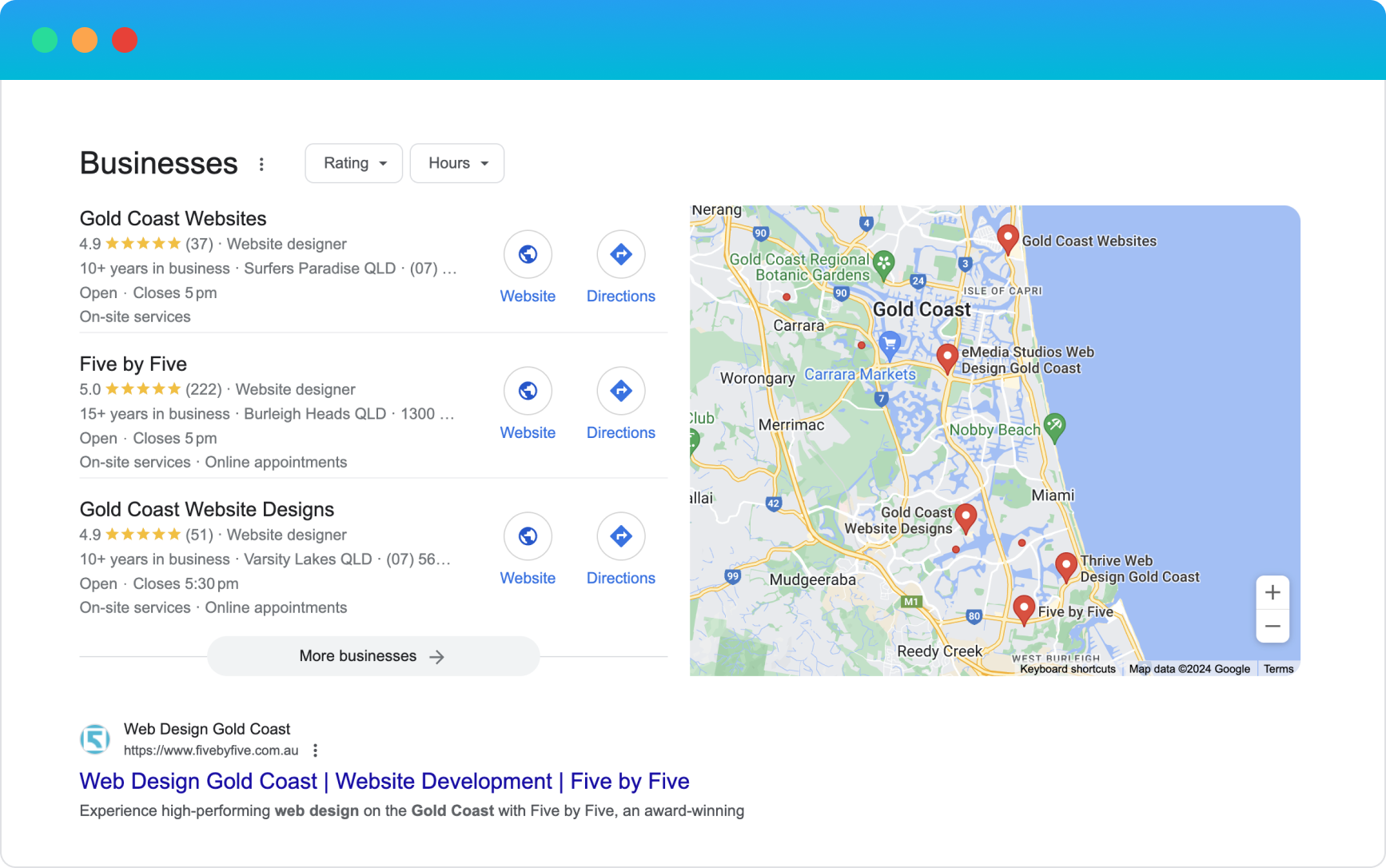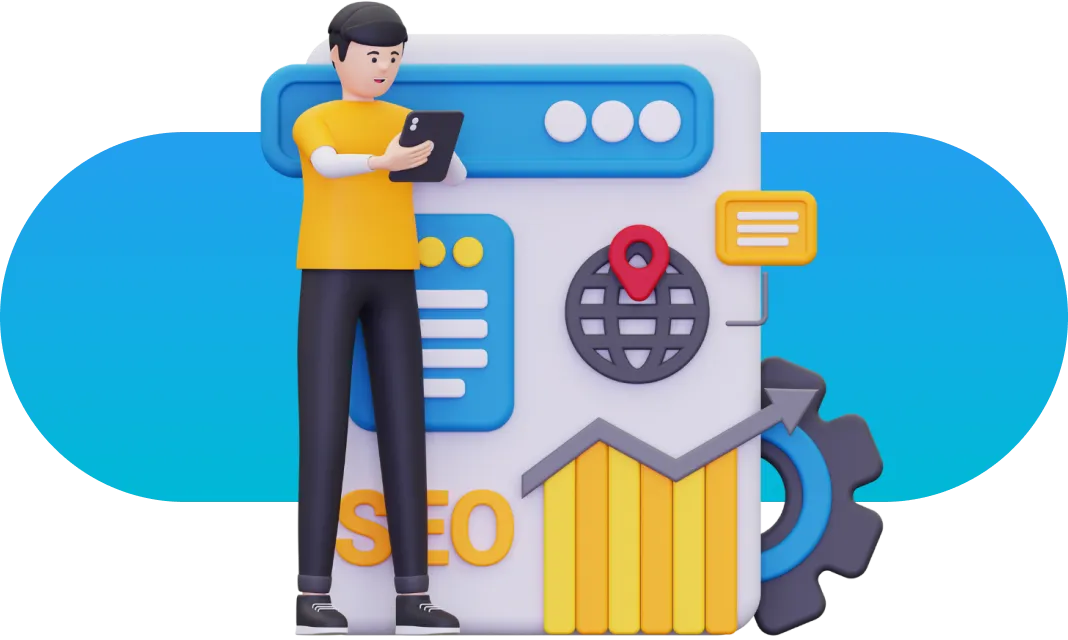Are you wondering how your business can stand out to local customers? How to make sure your business appears first when someone in your suburb searches for products or services just like yours? How to be the go-to industry solution for your community?
Local SEO is your answer. This is how you get your business to appear in front of local customers who are actively searching for and ready to buy from you. It’s not about global dominance. It’s about making sure you are front and centre when someone in your area needs what you can offer.
Whether you’re a small business owner, service provider, or even a freelancer wanting to attract a local clientele, investing in local SEO should be a key part of your digital marketing plan. We are going to explain the difference between general and local SEO, the importance of local SEO for small businesses, and how to optimise your online presence to start seeing results. Plus, we’re giving away expert advice on how to solve common issues with local SEO like a pro (straight from our team of savvy search strategists!).

At Five by Five, we’re all about helping you share your magic through great looking, high performing websites. Whether you’re a new business in need of a wow-worthy digital launch, or an established business looking to refresh and replace your old site, we have the know-how and dedication to make it happen. Contact us today to get started.
Understanding Local SEO
What is Local SEO?
Local SEO (Search Engine Optimisation) is the process of optimising your business’s digital profile to become more visible in local search engine results, boost local traffic to your website, and increase brand awareness in your area.
Unlike other SEO strategies, which focus on magnifying a website’s visibility on a national or global scale, Local SEO targets ‘near me’ and location-based search queries e.g. SEO Gold Coast.
We’ve all been there – needing a plumber to fix a leaking toilet and searching ‘plumber near me’, or trying to find a good brunch spot on a weekend getaway and googling ‘best cafes in [suburb name]’.
The goal is to structure your online presence in a way that ensures your business sits at the top of any search results when potential customers in your area are looking for your products or services.
How does local SEO work?
When displaying search results, Google prioritises businesses that are most relevant, prominent, and geographically close to that user.
How does it figure this out? Well, on top of its usual algorithm metrics, it uses three key factors to determine which businesses to display in local search results.
Relevance: how closely a business matches the user's search query, considering factors such as business name, categories, and website content.
Distance: how far away the business is to the user's location – businesses closer to the user are more likely to appear in local search results.
Prominence: how reputable a business seems based on quantity and quality of reviews, mentions across the web, backlinks to their website, etc. – the better your online reputation, the higher you’ll rank.
When someone performs a local search, Google displays two main types of search results:
Local Pack Results: These results typically appear at the top of the results page as a map, with three to four local business listings relevant to the search query. These listings are accompanied by essential information such as business name, address, phone number, ratings, and website link.
Organic Local Results: Below the local pack are the organic search results relevant to the query. Businesses that have strong local SEO signals rank higher in these organic search results.

SEO vs Local SEO: What’s the difference?
You might have heard of SEO before. Maybe you’ve even incorporated SEO into your digital marketing strategy. But what exactly is the difference between traditional SEO and local SEO?
Both are strategies designed to improve a website’s visibility in search engine results, but they target different types of searches and audiences.
SEO (Search Engine Optimisation)
Focuses on optimising a website to rank higher in organic (non-paid) search results for relevant keywords, regardless of the searcher's location;
Accounts for various aspects of a website, including on-page factors (content, keywords, meta tags), off-page factors (backlinks, social signals), and technical factors (site speed, mobile-friendliness, site structure);
Aims to improve a website's visibility on a global or national scale, targeting a broad audience and competing with other websites worldwide or nationwide.
Local SEO (Local Search Engine Optimisation)
Focuses on optimising a website to rank higher in local search results, particularly for searches with local purchase intent (e.g. "plumber near me," "restaurants in [city]");
Involves curating a business’s online presence to ensure their website appears at the top of local search results, Google Maps, and other local directories;
Prioritises a business’s Google My Business profile, local citations (consistent NAP - Name, Address, Phone Number), local content creation, and gaining customer reviews;
Is essential for any business targeting customers within a specific geographic area, such as brick-and-mortar stores, service-based businesses, and professionals operating within a defined geographic area.
Can all business types benefit from Local SEO?
In short? No.
Local SEO is highly effective for businesses servicing a specific geographic area, but other business types (think e-commerce, SaaS, online coaches) would benefit from a different strategy.
Take an e-commerce brand, for example. Without physical stores, they have a national or even global customer base, so trying to rank high in search results for specific suburbs or cities wouldn’t make sense. Instead, they would target non-geographic specific keywords, aimed at ranking high in broader, non-local search results.
Similarly, businesses targeting very niche or specialised markets might find more success with content marketing, social media advertising, or other digital marketing strategies tailored to their specific audience.
Local SEO is invaluable for many businesses, without a doubt. But rather than jumping on the bandwagon, so to speak, consider the unique needs and objectives of your business, and strategise accordingly.

Key Components of Local SEO
Local SEO might seem overwhelming at first but it boils down to a few key elements that – when you nail them – will have you on your way to topping those search rankings and crushing your local competitors.
Here’s what you need to focus on to get started:
Your Google Business Profile
NAP consistency (sadly not the 20-minute power kind)
Defining keywords for local SEO
Google Business Profile (GBP) Optimisation
A Google Business Profile (formerly known as Google My Business) is a free tool provided by Google that allows organisations to manage their online presence across various Google platforms, including Google Search and Google Maps.
This is your direct line to local customers. Your GBP provides essential information about your business, such as its name, address, phone number, website, hours of operation, and any reviews your customers have left about their experience.
Claim and verify your profile: The first crucial step in optimising your GBP is to claim ownership of it. If a profile already exists for your business, claim it through Google's verification process so that you have control over the information displayed on your profile and can manage it effectively.
Provide accurate and complete information: Once you've claimed your GBP, make sure that all the information on that profile is accurate, consistent, and up to date. This includes your business name, address, phone number, website URL, hours of operation, and business category. Providing accurate information not only helps potential customers find and contact you but also improves your visibility in local search results.
Include compelling content: Make your GBP stand out by adding content that showcases your business. Uploading high-quality photos and videos that highlight your products, services, team members, and premises. Write an engaging business description that effectively communicates what makes your business unique and why customers should choose you. Engage with your community by responding to reviews, questions, and inquiries promptly – this is a great way to stay connected to the needs of your target market while building trust with potential customers!
NAP Consistency
The day we can recommend that you consistently take naps will be the day we have peaked as a service provider. But alas, today we’re talking about the acronym. NAP stands for Name, Address, and Phone Number.
This step is simple and sweet – make sure your business name, business address and business contact number are the same across all of your digital touchpoints!
NAP consistency across your website, social media profiles, Google Business Profile, and any other online directories or platforms that include your business’s details is vital. It boosts your credibility with search engines, and really, it verifies you as the professional you are.
You can get this done in three easy steps:
Audit your online presence. Check the contact information listed on your website (contact page, header, footer), your social media profiles, Google Business Profile, and other relevant online directories.
Correct any discrepancies in your business’s name, address, and phone number.
Regularly monitor and update these details as needed (we suggest using a tool like Brightlocal to easily manage your online profiles).
Defining Keywords for Local SEO
Incorporating location-based and industry-specific keywords into your website content, metadata, and online profiles allows search engines to gauge where your business is based, what industry you operate in, and the audience you’re going to be targeting. This makes it easier for those search engines to match your business with users searching for specific products or services in your area, and connects you to people who are actively seeking the solutions you offer.
To figure out what keywords to include, you’ll need to do some local SEO keyword research! Identify the terms and phrases your target audience is using when searching for businesses like yours. Some great tools to assist with this are Google Keyword Planner and SEMrush, which allow you to search your industry and location and view a list of relevant keywords. Check out our post on how to conduct keyword research for more guidance with this!
Once you’ve identified relevant keywords, it’s time to use them to optimise your website for local search. Strategically add your keywords to website content, meta tags, headings, and image alt text. (Pro tip: add them to your Google Business Profile and other online listings too – this will help to maximise your visibility across multiple platforms!).
It’s important to monitor your website’s performance and adjust your keyword strategy based on user behaviour and search trends. The most effective strategies are ones that evolve with you – this is not a set-and-forget solution!

When it comes to improving your local organic results, it’s important to set up your website structure in a way that gives your chosen keywords the best chance of ranking.
All too often, I see businesses with one “Our Services” page on their website, which summarises every single service they offer.
Pages like these will never rank high in organic results because search engines like Google display pages based on their relevance, authority, and the quality of content in relation to a user’s search query. Having multiple services listed on the one page dilutes the relevance of the content on that page.
Let’s take a plumber, for example, who has one of these “services” pages and offers blocked drain clearing.
If someone is searching for “blocked drains gold coast”, Google will display pages that meet its relevance, authority and content quality criteria.
Because this plumber’s “services” page talks about the 10+ services they offer, it doesn’t have the relevance or content quality to be eligible to appear in this search query example.
Instead, this plumber should create a separate website page with specific keywords for each of those 10+ services. The image below is an example of websites with dedicated landing pages that meet the above criteria Google is looking for.
How to level up your local SEO strategy
You’ve nailed the basics. Now what? There are a few extra things you can do to enhance your digital presence and really level up your local SEO efforts. Here are our top three.
Sourcing and managing reviews
Be honest, when was the last time you asked a customer for a review of your product or service? Unless people have a terrible experience (in which case they’ll shout about it from the rooftops), chances are most of your customers simply won’t think to leave a review on your Google Business Profile.
Google reviews directly impact your reputation online (remember, Google checks this when determining who to present first in search results). But, perhaps even more importantly, they also influence purchase decisions – in a big way. At Five by Five, our Google Reviews are responsible for attracting over 80% of the leads that come through our website!
So, if you have been sleeping on sourcing reviews from your customers, now is the time to start. And the good news is, all you have to do is ask.
Contact your clients or customers directly if you work closely with them (especially if you know they recently had a huge win or enjoyed amazing results from your product or service). Or, set up a simple email workflow that automatically sends your customers a review request after making a purchase or engaging your services. We certainly don’t recommend doing this all the time (can you imagine receiving a review request every time you bought a coffee?), but intentional and purposeful requests give your fans and loyal customers an opportunity to sing your praises for all to see.
Pro tip: Make sure you respond to all reviews, both positive and negative. Just like on social media, this engagement helps you stay connected to your customers, provides valuable insights into how you can improve, and it shows that you care!
Building out your backlinks
A backlink, also known as an inbound link or incoming link, is a hyperlink that directs from one website to another. Put simply, when you’re browsing on one website and you click on a link that takes you to a different website, you’ve just clicked on a backlink.
For example, a digital lifestyle publication might create an article on the ‘Top 10 Brunch Cafes on the Gold Coast’, and include a link to each cafe’s website in the article so that readers know where to find them online. Each of those cafes now have a backlink directing traffic to their respective websites.
Remember the three factors that Google uses to determine which business to display in search results? Backlinks help to increase #3 – your online prominence (or reputation). Websites with a high number of quality backlinks from reputable sources are deemed more trustworthy and are likely to rank higher.
So, how do you source backlinks for your website? This will largely depend on the industry you’re in, but we’ve got a few ideas to help get you started.
Create high-quality content: Develop informative, engaging, and shareable content that naturally attracts backlinks from other websites. This could include blog posts, infographics, videos, case studies, or industry reports.
Guest blogging: Contribute guest posts to relevant blogs or publications in your industry, and include a link back to your website in the author bio or within the content you’re sharing.
Join local directories and listings: Submit your business to local directories, industry-specific directories, and online listings. Ensure that your NAP (Name, Address, Phone Number) information is consistent across all directories to improve credibility and visibility.
Build relationships: Network with influencers, bloggers, journalists, and other businesses in your industry. Collaborate on content, partnerships, or events that can lead to natural backlinks from their websites.
Building out your backlinks
Think of localised content as the cherry on the cake that is your local SEO strategy. Optional, but a great way to really round out your local SEO efforts. We’re talking blog posts, articles, local guides, press releases, engaging videos – even social media content that highlights local events, news, trends, and community involvement.
If you’re just starting to produce long-form content as a part of your marketing strategy, these content pieces might not attract many visitors on their own. And that’s okay! What they do help with is connecting you to your local audience, and establishing your brand as a reputable authority in your niche. Plus, search engines still factor these pages into their algorithms and use page content to assess the quality and relevance of the website overall. Certainly not a necessity, but something to consider!

Tracking and measuring Local SEO success
How can you ensure you’re getting the most out of your local SEO strategy? By knowing your numbers.
Ahh, yes. That old adage. It’s not always fun, but it is necessary to make sure you’re on the right track. Here’s why.
Performance evaluation: Tracking website and search analytics with tools like Google Analytics and Google Search Console gives you the opportunity and means to assess the effectiveness of your local SEO efforts. Monitoring metrics such as your search rankings, website traffic, and conversion rates will provide you with valuable insights into what is working well and what needs improvement.
Identifying opportunities: Analysing this data will highlight any gaps or opportunities for continued growth. Stay on top of trends in local search queries, your competitors’ rankings, and user engagement with your GBP profile. This will help you uncover areas for further improvement, and also to direct your resources into what’s working for you!
ROI Assessment: We want to spend our time and resources on what gets us results. Measuring the impact of your local SEO strategy enables you to calculate the return on investment (ROI) of your efforts. By correlating SEO activities with key performance indicators (KPIs) such as leads generated or revenue generated, you can determine the impact on your bottom line (and budget or re-strategise accordingly!).
If you’re a small business owner, service provider, or even a freelancer wanting to attract a local clientele, investing in local SEO should be a key part of your digital marketing plan. It’s an incredibly effective and low-cost way to get your business in front of local customers who are actively searching for and ready to buy from you, while boosting brand awareness in your area and establishing you as the go-to solution for your industry. Nail the basics, then take your time with one or two of the level-ups we’ve covered here, and you’ll start climbing the Google ranks and elbowing your competitors out of the way in no time.
At Five by Five, we understand the unique challenges and opportunities that come with local SEO. We’re committed to helping businesses like yours share their magic online, transforming digital footprints into real-world success. With our expertise, you can turn local searches into local triumphs, ensuring your business is the go-to choice in your community.
Whether you’re starting your local SEO journey or looking to enhance your existing efforts, remember that success lies in understanding your audience, being consistent in your efforts, and adapting to the changing digital environment.
Ready to make your mark in local search? Reach out to us at Five by Five. Let’s work together to make your business the local legend it deserves to be.





